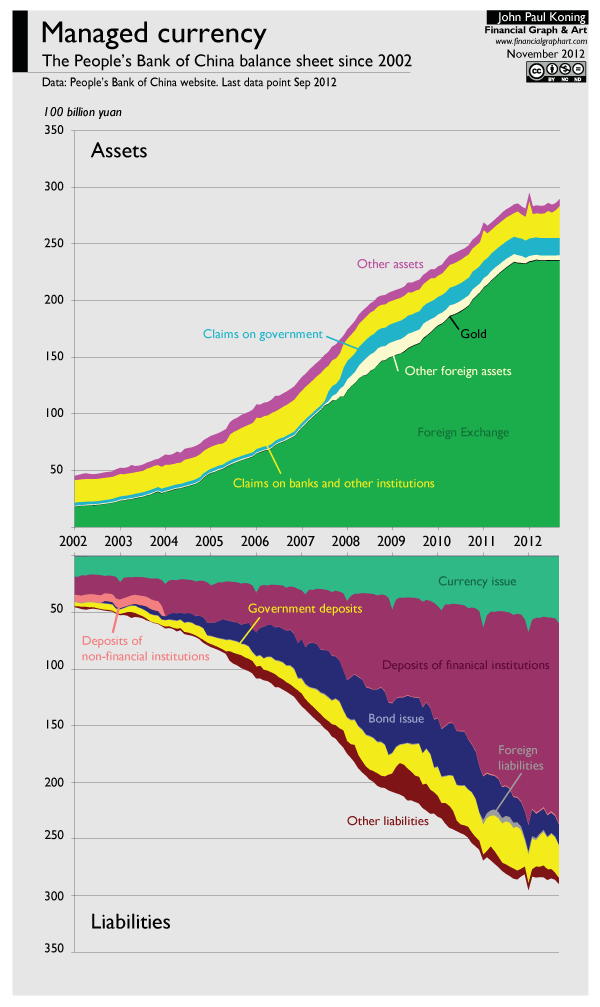David Glasner and Scott Sumner have posts on Chinese monetary policy. They both inquire about the People's Bank of China (PBoC) balance sheet. I've affixed a chart of it below.
Here's a quick rundown of how the PBoC balance sheet changes. The PBoC sets the yuan-to-dollar exchange rate at some rate below what it would in a free market. Chinese exporters thereby enjoy a subsidy. The law requires that the foreign currency that exporters earn overseas be repatriated and exchanged for yuan. The PBoC prints yuan (bottom green area) or provides deposits (bottom purple area), receiving this foreign exchange in return (top green area).
By creating such large quantities of liquid currency and reserves, the PBoC will force the domestic price level to rise. In order to prevent this inflation, the Bank must "sterilize", or mop up the liquidity it has created. It does this by issuing bonds (dark blue area at bottom) to domestic banks in exchange for currency and reserves (bottom purple and green). Thus liquid instruments are replaced by an illiquid instrument, bonds. The PBoC also forces banks to hold large quantities of required reserves (bottom purple area), which immobilizes what would otherwise be a fairly liquid instrument. In this way the rise in the domestic price level can be temporarily prevented. The PBoC could also sterilize by selling domestic assets (top pink, blue, or yellow areas) and retiring the currency and reserves it receives. But given that domestic assets held on the PBoC balance sheet haven't changed much over the years, it's likely that different means are being found to sterilize.
Here's a quick rundown of how the PBoC balance sheet changes. The PBoC sets the yuan-to-dollar exchange rate at some rate below what it would in a free market. Chinese exporters thereby enjoy a subsidy. The law requires that the foreign currency that exporters earn overseas be repatriated and exchanged for yuan. The PBoC prints yuan (bottom green area) or provides deposits (bottom purple area), receiving this foreign exchange in return (top green area).
(scribd pdf)
By creating such large quantities of liquid currency and reserves, the PBoC will force the domestic price level to rise. In order to prevent this inflation, the Bank must "sterilize", or mop up the liquidity it has created. It does this by issuing bonds (dark blue area at bottom) to domestic banks in exchange for currency and reserves (bottom purple and green). Thus liquid instruments are replaced by an illiquid instrument, bonds. The PBoC also forces banks to hold large quantities of required reserves (bottom purple area), which immobilizes what would otherwise be a fairly liquid instrument. In this way the rise in the domestic price level can be temporarily prevented. The PBoC could also sterilize by selling domestic assets (top pink, blue, or yellow areas) and retiring the currency and reserves it receives. But given that domestic assets held on the PBoC balance sheet haven't changed much over the years, it's likely that different means are being found to sterilize.
Related Posts

Subscribe Our Newsletter
